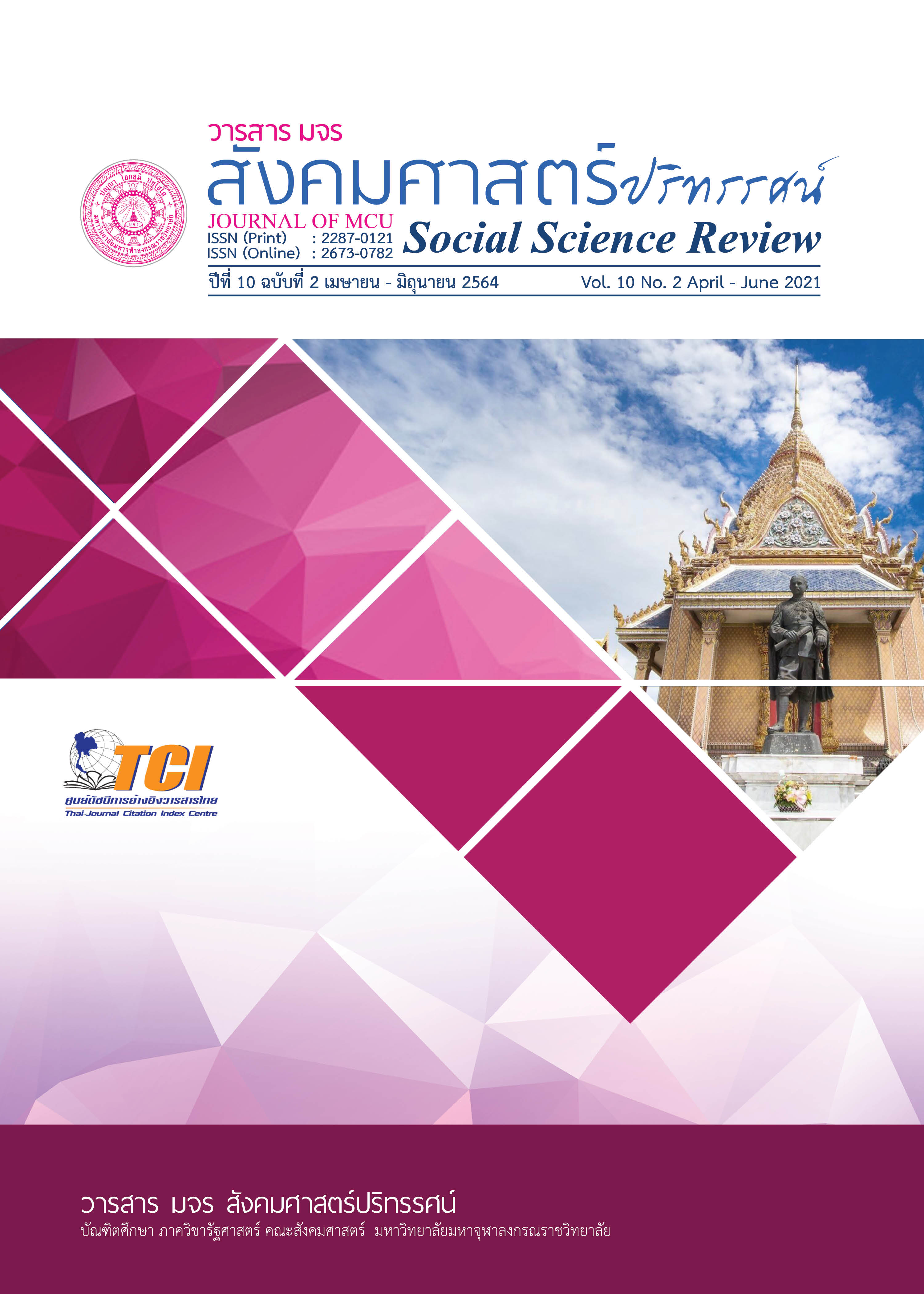รูปแบบการเผยแผ่พระพุทธศาสนาของพระสงฆ์ที่เหมาะสม กับการเรียนรู้ในศตวรรษที่ 21
คำสำคัญ:
การเผยแผ่, พระพุทธศาสนา, ศตวรรษที่ 21บทคัดย่อ
บทความวิจัยนี้มีวัตถุประสงค์เพื่อศึกษารูปแบบ พัฒนาการ บริบท สภาพปัจจุบันและวิเคราะห์รูปแบบการเผยแผ่พระพุทธศาสนาของพระสงฆ์ไทยที่เหมาะสมกับการเรียนรู้ในศตวรรษที่ 21 รูปแบบการวิจัยเชิงเอกสาร การวิจัยเชิงคุณภาพ เก็บข้อมูลด้วยการสัมภาษณ์เชิงลึก จากผู้ให้ข้อมูลสำคัญ จำนวน 20 รูป/คน และการสนทนากลุ่มเฉพาะจากผู้เชี่ยวชาญ จำนวน 12 รูป/คน เมื่อได้ข้อมูลมาแล้วนำมาประมวลผลเพื่อวิเคราะห์ สังเคราะห์หาลักษณะร่วม และข้อสรุปร่วม
ผลการวิจัยพบว่า 1) รูปแบบและพัฒนาการการเผยแผ่พระพุทธศาสนาของพระสงฆ์ไทย พบว่าการเผยแผ่พระพุทธศาสนาของพระสงฆ์ไทยในอดีตเน้นการเทศน์ การประกอบพิธีกรรมเป็นหลัก และพัฒนามาใช้งานด้านการพัฒนาสังคมมาเป็นฐานในการเผยแผ่พระพุทธศาสนา ที่ได้ช่วยรวมชาติหรือสร้างชาติทั้งในส่วนของการหลอมรวมทางด้านจิตวิญญาณของคนไทย 2) บริบทและสภาพปัจจุบันของการเรียนรู้ในศตวรรษที่ 21 พบว่า การเรียนรู้มีบริบทในการพัฒนาคนให้เป็นมนุษย์ที่สมบูรณ์ทั้งร่างกายและจิตใจ สติปัญญา ความรู้และคุณธรรม มีจริยธรรมและวัฒนธรรมในการดำรงชีวิตอย่างสมดุล มีทักษะจำเป็นและสามารถอยู่ร่วมกับผู้อื่น 3) วิเคราะห์รูปแบบการเผยแผ่พระพุทธศาสนาของพระสงฆ์ไทยที่เหมาะสมกับการเรียนรู้ในศตวรรษที่ 21 พบว่าผู้ให้การสนับสนุนสามารถปรับรูปแบบเพื่อช่วยเหลือให้การสนับสนุนพระที่เป็นนักเผยแผ่ นักพัฒนา ให้ทำงานได้สะดวก ผ่านการใช้เทคโนโลยีต่าง ๆ ที่ถูกต้องและทันสมัย
เอกสารอ้างอิง
ดวงเดือน พันธุมนาวิน และเพ็ญแข ประจนปัจจนึก. (2520). จริยธรรมของเยาวชนไทย. (รายงานการวิจัย). กรุงเทพฯ: มหาวิทยาลัยศรีนครินทรวิโรฒประสานมิตร.
บรรเทา กิตติศักดิ์. (2542). จริยธรรมทางการศึกษา. กรุงเทพฯ: มหาวิทยาลัยเกษตรศาสตร์.
บุญส่ง หาญพานิช. (2546). การพัฒนารูปแบบการบริหารจัดการความรู้ในสถาบันอุดมศึกษาไทย. (วิทยานิพนธ์ปริญญาครุศาสตร์ดุษฎีบัณฑิต). กรุงเทพฯ: จุฬาลงกรณ์มหาวิทยาลัย.
พระธรรมปิฎก (ปอ. ปยุตฺโต). (2556). พจนานุกรมพุทธศาสตร์ ฉบับประมวลธรรม. กรุงเทพฯ : โรงพิมพ์มหาจุฬาลงกรณราชวิทยาลัย.
มหาวิทยาลัยมหาจุฬาลงกรณราชวิทยาลัย. (2539). พระไตรปิฎกภาษาไทยฉบับมหาจุฬาลงกรณราชวิทยาลัย. กรุงเทพฯ: โรงพิมพ์มหาจุฬาลงกรณราชวิทยาลัย.
วรภัทร์ ภู่เจริญ. (2547). คิดอย่างเป็นระบบและเทคนิคการแก้ปัญหา. กรุงเทพฯ: สำนักพิมพ์อริยชน จำกัด.
วัลลภา จันทร์เพ็ญ. (2544). รูปแบบการจัดกิจกรรมเพื่อพัฒนาจริยธรรม ของนักศึกษาช่างอุตสาหกรรมตามแนวคิดการปรับพฤติกรรมทางปัญญา (วิทยานิพนธ์ปริญญาครุศาสตรดุษฎีบัณฑิต สาขาวิชาหลักสูตรและการสอน). กรุงเทพฯ: จุฬาลงกรณ์มหาวิทยาลัย.
สมาน งามสนิท. (2542). องค์ประกอบของการสื่อสารที่พึงประสงค์ตามแนวแห่งพุทธะ. กรุงเทพฯ: มหาจุฬาลงกรณราชวิทยาลัย.
สุมาลี ชัยเจริญ. 2550. ศึกษาศักยภาพด้านการคิดของผู้เรียน ที่เรียนจากนวัตกรรมการ เรียนรู้ที่ส่งเสริมศักยภาพด้านการคิด (รายงานการวิจัย). ขอนแก่น: มหาวิทยาลัยขอนแก่น.
ดาวน์โหลด
เผยแพร่แล้ว
รูปแบบการอ้างอิง
ฉบับ
ประเภทบทความ
สัญญาอนุญาต
ลิขสิทธิ์ (c) 2021 วารสาร มจร สังคมศาสตร์ปริทรรศน์

อนุญาตภายใต้เงื่อนไข Creative Commons Attribution-NonCommercial-NoDerivatives 4.0 International License.
เพื่อให้เป็นไปตามกฎหมายลิขสิทธิ์ ผู้นิพนธ์ทุกท่านต้องลงลายมือชื่อในแบบฟอร์มใบมอบลิขสิทธิ์บทความให้แก่วารสารฯ พร้อมกับบทความต้นฉบับที่ได้แก้ไขครั้งสุดท้าย นอกจากนี้ ผู้นิพนธ์ทุกท่านต้องยืนยันว่าบทความต้นฉบับที่ส่งมาตีพิมพ์นั้น ได้ส่งมาตีพิมพ์เฉพาะในวารสาร มจร สังคมศาสตร์ปริทรรศน์ เพียงแห่งเดียวเท่านั้น หากมีการใช้ภาพหรือตารางหรือเนื้อหาอื่นๆ ของผู้นิพนธ์อื่นที่ปรากฏในสิ่งตีพิมพ์อื่นมาแล้ว ผู้นิพนธ์ต้องขออนุญาตเจ้าของลิขสิทธิ์ก่อน พร้อมทั้งแสดงหนังสือที่ได้รับการยินยอมต่อบรรณาธิการ ก่อนที่บทความจะได้รับการตีพิมพ์ หากไม่เป็นไปตามข้อกำหนดเบื้องต้น ทางวารสารจะถอดบทความของท่านออกโดยไม่มีข้อยกเว้นใดๆ ทั้งสิ้น





